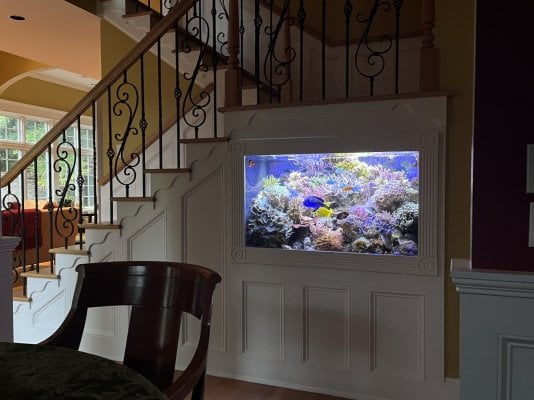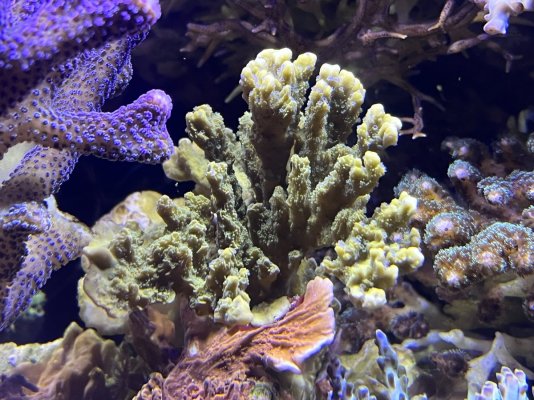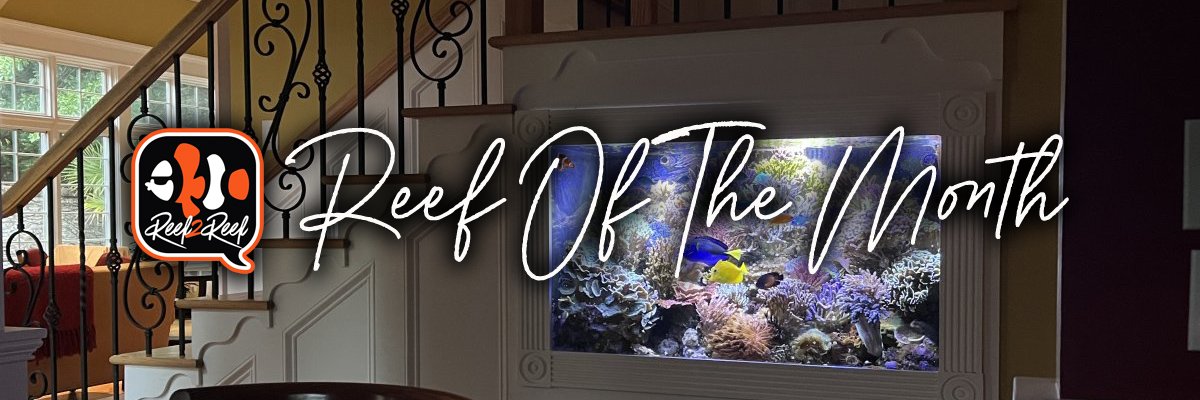R2R Username: @Ancient Mariner
Build Thread: Custom 100 gallon built in stair landing with slide access
Introduction
I'm Ken Figueroa from Decatur, Georgia USA, and I'm honored that my reef has been picked as the May 2023 Reef of the Month. The tank is built into a staircase landing with an aquarium room under the landing and accessed through a coat closet. The built in aquarium and aquarium room were built in 2002 when we did a full house renovation. The tank slides out about 8 inches on a platform built on industrial slides. This allows for reef access.
The aquarium room has a sink and a tiled shower pan with a drain. I have an RO/DI unit hooked up to the faucet but I only use the pre-filter and carbon filter cartridges, effectively meaning I do not use RO/DI water. I have a 50 gallon garbage can with a float valve that holds the filtered water for top off and water changes. There is a high volume bathroom ventilation fan with a high volume in-line supplemental fan that is constantly on. I use a cheap small electric fan along with a 3 fan GHL aquarium cooling fan to move air through the area in the floor joists where the lights are mounted and along the water surface of the display tank. There are 2 GFCI electrical outlets (1 four plug and 1 two plug) on 2 dedicated circuits.
The current reef was started in 2019 when I replaced the original acrylic aquarium with a new one. Only 2 corals (pavona and mummy eye chalice) and 1 fish (yellow tang) from the original tank made it into the new tank.
System Profile
- Display tank: Custom built 3/4" acrylic 40" X 24" high X 26" deep, eurobraced with exterior overflow box (Midwest Custom Aquarium). There is no center brace since the metal halide lights would melt any acrylic in the central area at the top.
- Glass or Acrylic: Acrylic, because in the 1990's I had a glass aquarium that blew a seam and I never wanted to go through that trauma again. Plus, acrylic is lightweight which is extra important due to the design of the slide out stand.
- Stand: Custom built slide out stand made with industrial strength slides (rated at 800 pounds each) and a 3/4" plywood platform.
The tank is built into a staircase landing and to be at the proper height for viewing when seated the top of the tank would only be 2.5" from the bottom of the landing joists. So the ability to slide the tank out 8" allows access. - Sump: Modified stock 55-gallon acrylic aquarium. There are 4 drilled one-inch holes evenly spaced at the bottom front of the tank for external pump attachments. However I only use 2 of the holes currently, one for the return pump and one for the protein skimmer pump. There is no filtration media, no live rock or biomedia, no sand, no macroalgae. I do not have a refugium.
- Protein skimmer: External Aqua-C EV-240 from 2002 driven by Iwaki MD-40RT external pump.
- Carbon/phosphate filtration: None
- Return pump: External Iwaki 40XRT
- Water circulation: 2 MP40 Vortech set to Reef Crest Random Mode up to 90% max flow. A 4K Maxspect Gyre set to alternate 100% forward flow for 40 secs and 100% reverse flow for 20 secs
- Lighting: 2 400w metal halide bulbs currently 20K Radium bulbs driven by Icecap electronic ballast, 1 Reefbrite XHO 50/50 LED 36" strip, and 1 Reefbrite XHO white LED 36" strip
- Calcium/alkalinity/magnesium dosing equipment: Calcium reactor Korallin C-1502 from 2002. It runs at 100 bubbles/minute at a steady effluent stream with no pH probe. Red Sea 4-head ReefDoser dosing pump for 2-part Ca/alkalinity.
- Auto top-off: Tunze Osmolator 3155
- Heating/cooling: Arctica 1/3 hp chiller. No heater.
- System control: None
Water Circulation and Flow Summary and Objectives:
I designed the tank to be predominantly SPS. So high circulation flow was imperative. The 2 MP40's and the 4K Maxspect Gyre covers this requirement! The return flow from the sump is fairly insignificant.
Water Parameters:
- Temp: I have significant daily temperature variation because of the metal halides. In the summer, temps vary DAILY from 79-82F. In the winter, temps vary DAILY from 75-81F
- pH: Range >7.7 <8.0 (Salifert test kit)
- Specific gravity: 1.026
- NO3: 10 mg/l (Salifert test kit)
- Ca: 400 ppm
- Alk: 8-9 dKh
- Mg: Not tested and unknown
- PO4: <0.1ppm
- Ammonia and nitrites: Not tested, but assumed to be 0
What salt mix do you use? Instant Ocean Reef Crystals (Easily available and cheap)
What kind of rock did you start with?
1/2 old cultured artificial live rock from my previous reef, 1/2 dry rock (Walt Smith Reef Rock 2.1). I also used 5-10lb. of muck from my previous reef (it was bare bottom so the muck was accumulated rock debris, eroded coral, and miscellaneous debris and organic matter)
What is your substrate?
As mentioned, I used several pounds of accumulated debris from my previous reef. I used 1 bag of medium grained aragonite to trap the muck as I added water and rock so that the water circulation wouldn't stir it up. Over the initial year of the reef, I siphoned out a good amount of the aragonite as it became covered with nuisance algae and cyano. So it is basically bare bottom.
Calcium/Alkalinity/Magnesium Summary and Objectives:
I concentrate on trying to keep alkalinity at >8 dKh. The alk uptake is so high that if my Ca reactor or 2-part doser malfunctions alkalinity can drop to 4 or 5 dKh very rapidly! So I try to keep dKh at least mid 8 to cushion any equipment malfunction. Having 2 types of alkalinity supplementation also acts as a buffer if one system malfunctions. Calcium levels are very stable and I test them only every 2 months at the most.
I ignore magnesium.
What and how do you dose for the big 3 (alk/cal/mag)?
Calcium reactor and ESV 2-part dosing via automatic doser (currently 60ml/day of each part). I use additional powder buffer (any and all brands) on an as-needed basis, which is usually 1-2 tablespoons weekly.
Are you dosing anything else for your reef health (carbon dosing, aminos, etc.)? I have NEVER dosed any trace elements, nitrate, phosphate, or nutrients. I have never used any type of coral food.
Lighting Summary and Objectives:
HIGH light for SPS growth from top to bottom! 2 400 watt metal halides are NOT TOO MUCH for this goal. The ReefBrite XHO LED strips are only for viewing purposes. I do not see them as contributing much to SPS growth or health, although they can't hurt.
The metal halide light fixture is built into the floor joist of the stair landing. The ReefBrite XHO strips simply rest on the top of the tank and can be easily moved.
I started with metal halides in 2002 and when I restarted this current reef in 2019 I considered switching to LED's. However because I didn't know how reliable LED's would be in the cramped high heat/high humidity area where the lights are located I didn't want to change lighting types. I knew that metal halides were reliable and worked well. So I stuck with my old light fixture.
Photoperiod
Reefbrite XHO's on 10AM-11PM
Metal halides on 11AM-7PM
No special LED ramp up or light settings.
Filtration and Water Quality Summary and Objectives:
What is your export strategy? Protein skimmer and biweekly 20% water changes
What is your maintenance routine?
Daily: Feed the fish twice daily. Check the calcium reactor and make sure it's running properly.
Weekly: Test alkalinity once or twice a week. Clean the front glass every 3-4 days. Clean the side panels weekly. 20% water change every 2 weeks.
Other:
Fill the calcium reactor with substrate every 2 months.
Refill 2-part dosing solutions every 2 months.
Check calcium, pH, nitrate, phosphate every 2-3 months.
Clean the skimmer every 3-4 months.
Clean circulation pumps every 3-4 months.
Change water prefilter and charcoal filter every 6 months.
Wipe clean LED strip lights every 6 months.
CO2 tank (20lb) refill every 12 months.
Change metal halide bulbs every 12 months.
Tank Inhabitants
Fish:
- Yellow tang
- Blue tang
- Coral Beauty angelfish
- Lawnmower blenny
- 7 blue chromis
- 2 ocellaris clownfish
- citron goby
- lyretail anthias
Other Invertebrates:
- Tetralia cinctipes (commensal coral crab)
- 2 Trapezia commensal coral crabs
- Lysmata striped cleaner shrimp
Various Acropora:
- Cali Tort
- ORA Yellow tip green staghorn
- ORA The Carl
- ORA Hawkins
- ORA Purple plasma
- ORA Miami Orchid
- ORA Indo Purple tip
- ORA Skyline granulosa
- ORA Pearlberry
- ORA Green Planet
- ORA Imperial stag
- WWC Yellow tips
- RR Pink Cadillac
- PC Rainbow
- Green Slimer
- Red Dragon
- Orange Dragon
Various Montipora:
- Green/purple/orange branching
- Orange/purple/green plating
- ORA Lantana Montipora
Various Seriatopora:
- Pink bird's nest
- Bird of paradise
- Green seriatopora
Various stylophora
- Purple (Milka)
- ORA green stylophora
- ORA Stellar stylophora
Various pocillopora:
- Vivid's neon green
- Vivid's pink
- ORA pink, green, pink and green
- Generic brown/tan
Others:
- ORA yellow porites
- ORA Sprung's stunner
- ORA red goniopora
- Pectinia
- Duncan coral
- 3 types of Turbinaria sp.
Softies:
- ORA neon green sinularia
- generic tan sinularia sp.?
- Kenya tree
- Cespitularia
- Pom Pom Xenia
Fish and Coral Feeding:
Frozen mysis 1 cube twice a day
2X2 inch nori square every other day
2 algae wafers every other day.
I throw in frozen herbivore cubes every now and then.
I do not specifically feed the corals.
How did you decide what to keep in your tank?
I decided to stick with hardy, proven old school corals. This hobby is hard enough to keep "easy" corals. Initially I bought corals that did well in my previous reefs, and these were mainly ORA corals. I did a mix of all SPS types from the beginning but I really should have held off on Acropora for 6-12 months. I lost many frags early on. I wanted some LPS and softies and I picked what I thought would like high light. But all LPS ended up needing to be at the bottom in shade and my softies struggled as well. It is challenging to mix coral types in a high light, high flow system.
Any stocking regrets?
Although I have acropora frags from the 1st 2-3 months that have survived and grown, I should have waited 6-12 months to reduce losses. I lost so many acropora frags early on...even ones that have eventually thrived in the exact same conditions of light, flow, and chemistry except for the maturity of the reef. For example, I lost 2 ORA Pearl Berries, 2 ORA Purple plasma, and 2 PC Rainbows. The 3rd set of these frags were the charm!
Any fish, invert, or coral you will NEVER keep? Any organism that is known to be nearly impossible to keep alive in captivity.
What do you love most about the hobby? The beauty, complexity, and challenge of SPS corals.
How long have you been doing this?
I have had saltwater aquariums since high school in the late 1970's. My first attempt at coral was in 1991 with green star polyps and an elegance coral (Catalaphyllia sp.) that in retrospect shouldn't have survived.
Who was responsible for getting you into the hobby? I loved wandering the aquarium sections that were in department stores in the 1970's.
Who or what in the hobby most influences/inspires you? I was inspired into reefkeeping by the aquarium hobby magazines. They opened my eyes as to what was possible.
If you could have any tank, what size would it be and why?
This is about the best size for me: large enough to cram in all types of SPS but small enough to discreetly display without taking up major living space.
Favorite fish?
Lawnmower blenny
Favorite coral?
Cali tort
Favorite invert?
Tetralia commensal coral crab. It hitchhiked on a frag, made its home in the Cali tort, and is now 3 years old.
How do you typically get over setbacks?
Take a deep breath and understand that this is a hard and frustrating hobby at times and that success comes with patience and persistence in proven husbandry practices.
Have you faced any major challenges with this particular tank, and if so, how did you overcome?
This the fourth reef setup in this tank. Previous attempts failed due to prolonged power outages, chiller failure with prolonged temps in the 90'sF, and outright negligence. The challenge of getting to my desired SPS dominant reef always kept me in the hobby.
What's the best thing you ever bought for your tank?
Auto doser for 2-part Ca/buffer supplements. It has allowed me to keep up with the ups and downs of reef uptake and Ca reactor finickiness.
What are your future plans for improvement/upgrade of the tank? I am considering remote monitoring, testing, and dosing systems for prolonged vacations.
Any special tips for success or advice you'd like to share with other reefers?
Old school approaches are still valid and should be viewed as the baseline. Be wary of the newer theories, approaches, and recommendations. If you are having difficulties, do not be quick to start all over from scratch. It's best to let the tank rest (weeks to months?), minimize additives, equipment changes and parameter adjustments, and go back to a very simple and basic approach.

















